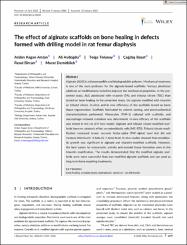| dc.contributor.author | Arslan, Arslan Kağan | |
| dc.contributor.author | Aydoğdu, Ali | |
| dc.contributor.author | Tolunay, Tolga | |
| dc.contributor.author | Basat, Çağdaş | |
| dc.contributor.author | Bircan, Resul | |
| dc.contributor.author | Demirbilek, Murat | |
| dc.date.accessioned | 2025-04-07T13:04:15Z | |
| dc.date.available | 2025-04-07T13:04:15Z | |
| dc.date.issued | 2023 | en_US |
| dc.identifier.citation | Arslan, A. K., Aydoğdu, A., Tolunay, T., Basat, Ç., Bircan, R., & Demirbilek, M. (2023). The effect of alginate scaffolds on bone healing in defects formed with drilling model in rat femur diaphysis. Journal of Biomedical Materials Research Part B: Applied Biomaterials, 111(6), 1299-1308. | en_US |
| dc.identifier.issn | 15524973 | |
| dc.identifier.uri | https://10.1002/jbm.b.35233 | |
| dc.identifier.uri | https://hdl.handle.net/20.500.12513/7225 | |
| dc.description.abstract | Alginate (ALG) is a biocompatible and biodegradable polymer. Mechanical weakness is one of the main problems for the alginate-based scaffolds. Various plasticizer additives or modifications tested to improve the mechanical properties. In the presented study, ALG plasticized with triacetin (TA), and tributyl citrate (TBC) than tested on bone healing. In the presented study, the alginate modified with triacetin or tributyl citrate. In-vitro, and in-vivo efficiency of the scaffolds tested on bone tissue regeneration. Scaffolds fabricated by solvent casting, and physicochemical characterizations performed. Monocytes (THP-1) cultured with scaffolds, and macrophage-released cytokines was determined. In-vivo efficacy of the scaffolds was tested in the rat drill hole model. Alginate and tributyl citrate-modified scaffolds have no cytotoxic effect on osteoblastic cells (MC-3T3). Tributyl citrate modification increased tumor necrosis factor-alpha (TNF-alpha) level but did not increase interleukin -1 beta (IL-1 beta) level. In vivo studies showed that osteoblastic growth was significant in alginate and triacetin-modified scaffolds. However, the best values for osteoclastic activity and osteoid tissue formation seen in the triacetin modification. The results demonstrated that the modified alginate scaffolds were more successful than non-modified alginate scaffolds and can used as long-term bone repairing treatments. © 2023 Wiley Periodicals LLC. | en_US |
| dc.language.iso | eng | en_US |
| dc.publisher | John Wiley and Sons Inc | en_US |
| dc.relation.isversionof | 10.1002/jbm.b.35233 | en_US |
| dc.rights | info:eu-repo/semantics/openAccess | en_US |
| dc.subject | Bone Healing | en_US |
| dc.subject | Cytokine Levels | en_US |
| dc.subject | Hydrophobic Plasticizer | en_US |
| dc.subject | Rat Drill Model | en_US |
| dc.title | The Effect of Alginate Scaffolds on Bone Healing in Defects Formed with Drilling Model in Rat Femur Diaphysis | en_US |
| dc.type | article | en_US |
| dc.relation.journal | Journal of Biomedical Materials Research - Part B Applied Biomaterials | en_US |
| dc.contributor.department | Tıp Fakültesi | en_US |
| dc.contributor.authorID | Hakkı Çağdaş Basat / 0000-0003-3301-2529 | en_US |
| dc.identifier.volume | 111 | en_US |
| dc.identifier.issue | 6 | en_US |
| dc.identifier.startpage | 1299 | en_US |
| dc.identifier.endpage | 1308 | en_US |
| dc.relation.publicationcategory | Makale - Uluslararası Hakemli Dergi - Kurum Öğretim Elemanı | en_US |


















